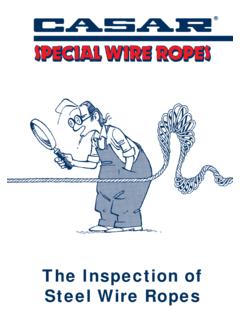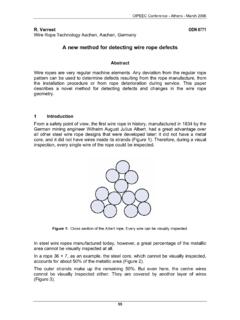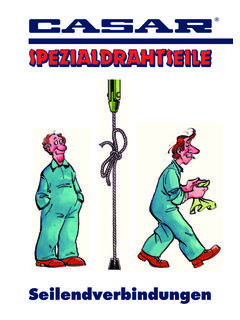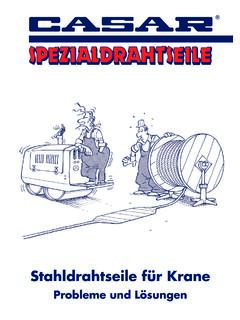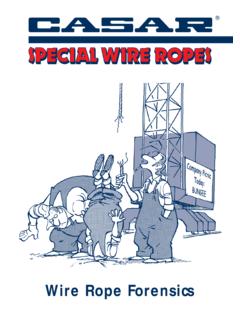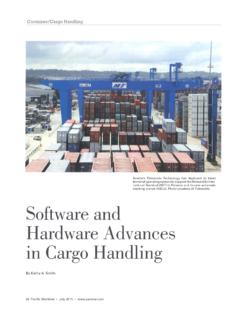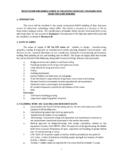Transcription of Steel Wire Ropes for Cranes - Wire Rope …
1 1 Steel wire Ropes for CranesProblems and Solutions21 Steel wire Ropes for CranesProblems and Solutions1 The Steel wire rope a multiply-redundant machine element 2 Problem: Local concentrations of wire breaks 3 Problem: Internal wire breaks Problem: Internal wire breaks in a 6-strand rope with Steel core Solution: 8-strand Ropes with an internal plastic layer 4 Problem: Internal wire breaks in conventional rotation-resistant Ropes Intermezzo: Rotation-resistant wire Ropes Solution: Rotation-resistant special wire Ropes with compacted rope core and compacted outer strands 5 Electro-magnetic wire rope testing 6 Problem: Corrosion of Steel wire Ropes Solution 1: Galvanized wires and plastic-coated rope cores Solution 2: Relubrication at regular intervals 7 Problem: Unsatisfactory wire rope fatigue life Solution 1: Use wire Ropes with a higher fatigue resistance Solution 2: Optimize your rope diameter Solution 3: Optimize your sheave diameter Solution 4: Avoid unnecessary bending fatigue Solution 5: Optimize wire rope tension-tension fatigue by reducing the rope diameter8 Problem: Loose strands and Solution 1: wire rope Solution 2: Steel sheaves instead of plastic Solution 3: Sheaves with wider Solution 4: Use Steel wire Ropes with an internal plastic Solution 5: Avoid tight sheaves9 Problem: Drum Solution 1: Grooved drums and Lebus Solution 2: wire Ropes in Langs lay execution with compacted outer strands10 Problem.
2 Good wire Ropes are Solution: Think about the overall costs!by Roland Verreet 2 4 5 6 6 8 11 12 12 13 14 14 15 15 16 19 19 20 22 24 25 25 27 27 27 27 27 28 29 21 The Steel wire rope a multiply-redundant machine elementImagine the following situation: An inspector has examined the hoist rope of an offshore crane and he has found 10,000 wire breaks. He insists that the rope is still in good working condition. Could this be true?Before wire Ropes were invented in 1834, chains were the most common lifting means. They have, however, one inherent disadvantage: Chains are linear arrange-ments of load bearing elements. If only one chain link fails, the whole system will fail (Fig. 1). Steel wire Ropes , on the other hand, are parallel arrangements of load bearing ele-ments.
3 If one rope element fails, the breaking strength of the wire rope is reduced only locally, and usually by less than 1% (Fig. 2). wire Ropes are multiple redundant systems of load bearing elements. In a redundant system every element which is necessary for the proper functioning of the system exists at least twice. For example, some of the parts of our human body are redun-dant: If we lose the sight in one eye, we can still see. And if we lose the hearing in one ear, we can still hear. If in a wire rope one wire fails, there are still about 250 other wires to carry the load. Fig. 1: The chain. The break of one ele- ment leads to the failure of the whole 2: The Steel wire rope . The break of one element has hardly any what will happen if during the service life of the rope more and more of these wires fail? If we have lost the sight in both eyes, we can no longer see.
4 And if we have lost the hearing in both ears, we can no longer hear. Therefore, should not also the wire rope fail if every single one of its 250 wires is broken?No. It sounds incredible, but a wire rope can still be in good condition even if every single one of its wires is broken 200 times! Figure 3 shows a schematic arrangement of the 250 wires making up a wire rope (for space reasons, only 30 wires are dis played). Along the rope length, every single one of the 250 wires is broken once. Each wire break, however, merely represents a local reduction of the rope s breaking strength. A few millimeters away from the location of the break the broken wire will again bear its full share of the load. If we have a very uniform distribution of the wire breaks along the rope length so that in every short piece of rope only one wire break can be found, the breaking strength of every single one of these sections is weakened by less than one percent only.
5 In a pull test this wire rope might achieve its full catalogue breaking strength even though every single one of its elements is broken! Still, there must be rules about how many broken wires per rope unit length that can be tolerated. The discard number of wire breaks is defi ned in the applicable 99100 Breaking strength [%]Fig. 3: Each wire break only leads to a local reduction of the rope s breaking or international standards and in the rules of the classifi cation societies as a permissible num ber of wire breaks per multiple of the wire rope diameter, per 6 x rope diameter (one rope lay length) or per 30 x rope diameter (5 rope lay lengths). Our inspector has found 10,000 wire breaks, but the dis card number was not reached in any single rope section of a length of 6 x d or 30 x d. So he was perfectly right in his decision to keep the rope in service.
6 This example shows that under normal conditions a wire rope is a very safe and reliable machine Problem: Local concentrations of wire breaksA few days later our inspector comes back from examining the hoist rope of a sis-ter crane . He has found only 15 wire breaks, but he insists on discarding the wire rope . After allowing 10,000 wire breaks on the fi rst crane , this sounds a bit strange. Could the inspector be wrong this time?If the wire breaks are concentrated in a very short section of the rope (Fig. 4), as a consequence of a misuse or because of a local mechanical damage, the reductions in breaking strength will add up to a critical value, and the rope must be discarded. Although 500m of the rope are as good as new, it must be discarded because 5cm are in a bad state. wire Ropes with a local concentration of wire breaks are unsafe.
7 Our inspector s decision to discard the rope is 4: A local concentration of wire Problem: Internal wire breaksThe hoist rope of a third crane of the same design does not show a single wire break. Fig. 5: Only about 20% of the metallic cross-section of the wire rope can be in- spected examining the rope , our inspector insists that it must be discarded. Why?During a visual rope examination, only the condition of the visible parts of outer wires can be evaluated. The metallic cross-section of the outer wires, however, only represents about 40% of the metallic cross-section of a rope , and only about half of the length of these outer wires is visible (Fig. 5). This means that during a visual rope inspection we can only examine the con dition of 20% of the metallic cross-section of the rope and we can only hope that the other 80% are in as good a condition.
8 Visual rope Inspection: 20% Evidence 80% HopeQuite often, however, the visible 20% of the cross-section look good, while a great num ber of wire breaks are concealed in the invisible part of the rope . wire Ropes with internal wire breaks and no external sign of damage are extremely Problem: Internal wire breaks in a 6 - strand rope with Steel coreDuring the examination of a wire rope , a 6x36 Warrington-Seale with a Steel core (Fig. 6), no outer wire breaks could be found. After bending the rope by hand, however, it was obvious that every single outer wire was broken inside the rope (Fig. 7).The contact conditions between the Steel core and the outer strands are characterized by very high local contact stresses (Fig. 8). Therefore the outer wires of the rope can break at their points of contact with the Steel core. The free length of the broken wires in Fig.
9 7 clearly shows that this is the case Solution: 8-strand Ropes with an internal plastic layerFigure 9 shows the cross-section of an 8-strand rope with a plastic layer between the Steel core and the outer strands (Casar Turboplast). The plastic layer does not only seal in the rope lubricant and protect the core against the corrosive environment, it also prevents metal-to-metal contact between the two strand layers and so reduces the contact pressures between the Steel core and the outer strands (Fig. 10). The plastic layer therefore successfully helps prevent internal wire 7: Numerous wire breaks at the points of contact between the Steel core and the outer 6: wire rope with Steel core (6x36 Warrington-Seale IWRC). Fig. 10:The plastic layer acts like a cushion. It reduces the contact stresses between the Steel core and the outer strands and helps prevent internal wire breaks (Casar Turboplast).
10 Fig. 8: Very high local contact stresses between the Steel core and the outer strands (6x36 Warrington- Seale IWRC).Fig. 9: 8-strand rope with a plastic layer between the Steel core and the outer strands (Casar Turboplast).84 Problem: Internal wire breaks in conventional rotation-resistant ropesIn rotation-resistant Ropes , the core is closed in the opposite direction to the outer strands. Therefore rotation-resistant Ropes are even more prone to internal wire breaks than 6- and 8-strand Ropes . Fig. 11 shows the cross-section of a rotation-resistant hoist rope 36x7. Fig. 12 shows the external surface of such a rope after a few months of service. Externally, the wire rope does not show a single wire break. After removing the layer of outer strands, many wire breaks appear on the rope core at the cross-over points between the two strand layers (Fig.)
